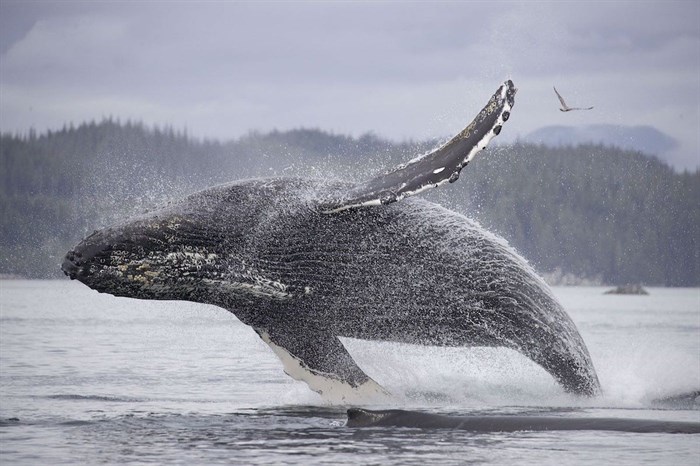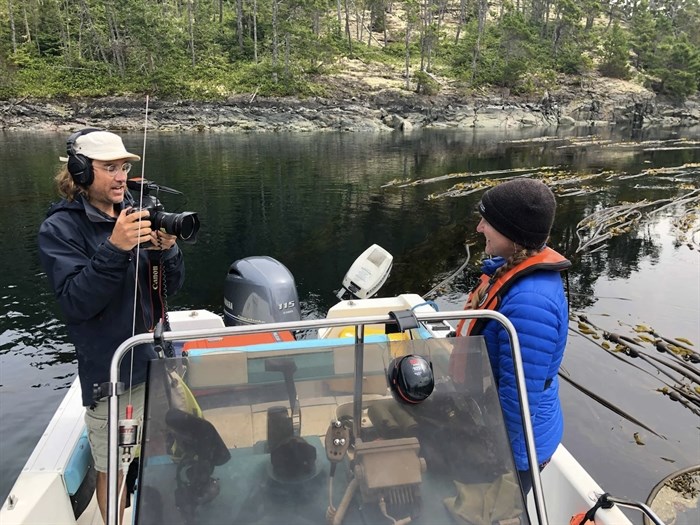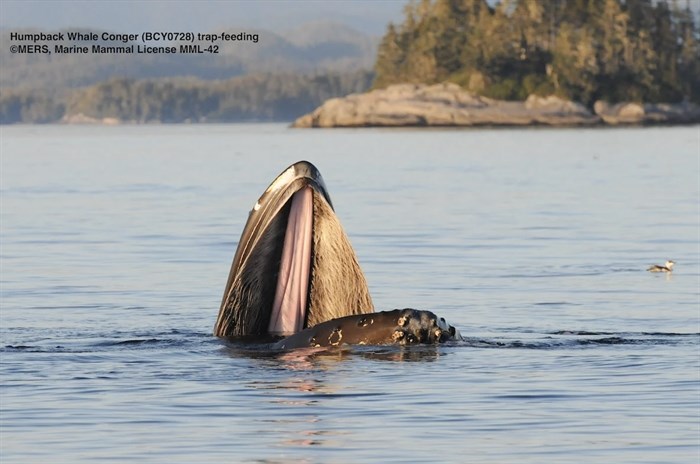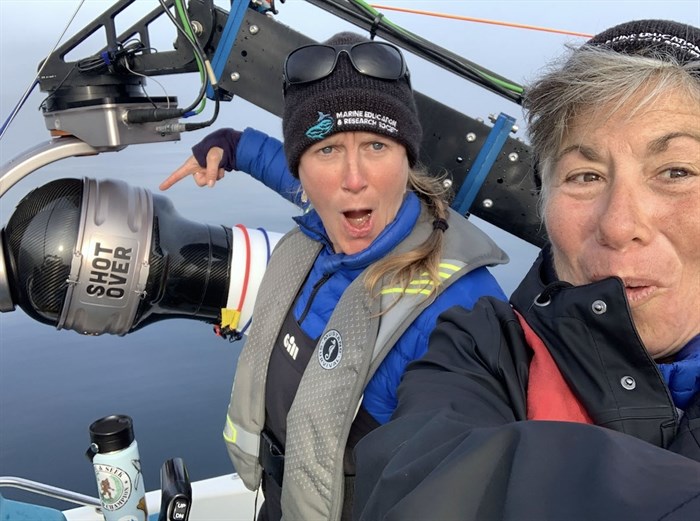
Whale researchers with the Marine Education and Research Society helped BBC's Planet Earth film humpbacks in B.C. waters for the show's latest series.
Image Credit: Hilroy (BCX1481) breaching next to Corporal (BCX1238) by Fredi Devas / BBC
December 10, 2023 - 7:00 AM
Whale researcher Jackie Hildering and her colleagues never imagined their work on humpbacks would capture the attention of the globe’s premier documentary series.
Or that whale poo would be of such interest to Planet Earth — BBC’s famous nature show.
“It’s surreal,” said Hildering, co-founder of the Marine Education and Research Society (MERS).
The team was left blinking in surprise at the first call in 2018 about helping the show film a novel humpback feeding strategy identified by MERs in the waters off Vancouver Island.
“That there was interest from something that is as big as Planet Earth III was beyond our imagining,” Hildering said.
Now B.C.’s humpbacks are featured in Episode 7 of the latest BBC series as heralds of hope for both the planet and people, she said. The episode explores some of the impacts when human civilization and the animal kingdom intersect.
The recent return of humpbacks to B.C. waters after being hunted to near extinction, the whales’ clever adaptation to a changing food web, and the myriad ways whales benefit the ocean ecosystem will be showcased, Hildering said.
“The story is that the humpbacks of northeastern Vancouver Island are giving hope to planet Earth,” she said.
“This is what happens when you give space for nature.”
Getting the ‘big picture’ on whale poop

BBC Planet Earth filmmaker Fredi Devas interviews Christie McMillan of MERS while in B.C. filming humpback whales.
Image Credit: SUBMITTED
MERS and the BBC film crew plied the waters of northern Vancouver Island in Hildering’s small boat for six weeks over the course of two summers to get compelling footage that highlighted the importance of protecting the whales.
A key objective was to document humpbacks that were trap feeding — a preferred fishing technique used by some whales that return every year to the region's waters to feed, she said.
But an inordinate amount of time was also dedicated to filming the humpbacks defecating.
“Everything comes down to poo,” said Hildering with a laugh. But whale waste is no joke, she stressed.
Planet Earth producer and director Fredi Devas agreed poo was part of the big picture when looking at all the ecosystem services whales provide.
Emerging research suggests that nutrient-rich excrement from humpbacks and other great whales not only fertilizes the marine environment but can also help mitigate global warming by locking up carbon from the atmosphere, Devas told Canada’s National Observer.

Iron-rich whale poo fertilizes the ocean, supercharging the food web and the absorption of carbon dioxide from the atmosphere.
Image Credit: SUBMITTED
A process known as the “whale carbon pump” is triggered when iron-rich fecal plumes released to the ocean’s surface spark an explosion of phytoplankton, which absorbs carbon dioxide.
In turn, these plankton feed other marine species, like krill or small fish, which also lock in carbon and act as food for an array of other marine animals — including whales.
Long-lived whales also store carbon in their massive bodies for upwards of a century. Even in death, the massive marine mammals serve the ecosystem, sinking to the deep ocean where the carbon in their bodies remains trapped or taken up by animals that feed on their carcasses.
An early study in the Antarctic Ocean alone suggested the poop of a pre-whaling population of about 120,000 sperm whales could trap 2.2 million tonnes of carbon a year.
A more recent study in the same region indicates that if populations of five different species of baleen whale hadn’t been decimated through commercial hunts, 400,000 tonnes of carbon would remain trapped upon their deaths as deadfall on the seafloor each year.
While populations are rising with the scale-back of industrial whaling, climate change could curb whale recovery and their carbon capture potential.
Carbon captured from whale deaths will likely reach 170,000 tonnes per year with a worst-case scenario of warming of up to 5 C by 2100. But twice the amount of carbon could be stored without global warming.
It’s astonishing what climate gains might be achieved by simply protecting great whales and helping them reach historic population levels, said Devas.
“It's this incredible good news story from the natural world that excites me enormously,” Devas said.
Dancing the ‘Conger Line’

Conger, the humpback first spotted using the new technique of trap feeding, is a main character in BBC Planet Earth's look at humpbacks.
Image Credit: SUBMITTED
The B.C. coast, where you can capture images of eagles in the sky, bears wading the shore, and whales leaping from the water at a single location makes it a top destination for wildlife filmmakers, Devas said.
However, it’s always an extra thrill to document new animal behaviour — like humpbacks trap feeding, a tactic that surfaced just over a decade ago, he said.
“Those animals are doing something no other humpbacks around the world are doing,” Devas said.
“So it was a great way to get into our story with something that is very, very new.”
Humpbacks in Vancouver Island waters typically lunge feed — where they rush into a dense school or “ball” of herring with their mouths open to capture as many fish as possible, Hildering said.
But in 2011, the MERS team observed some surprising behaviour by a well-known humpback named Conger.
The whale was hanging vertically in the water, barely moving, with his mouth wide open at the ocean surface. Researchers could see right into the roof of his mouth while he occasionally waved his pectoral fins toward his jaws.
It turns out Conger had devised an energy-efficient feeding technique to capture fish that weren’t packed densely together, Hildering said.
The unique method involves the whale lounging in the water, mouth agape, while fish fleeing seabirds seek shelter inside their massive jaws.
The whales then use their fins to push the fish further inside to trap their meal.
Conger may have been one of the first to use the tactic but now 32 whales have learned to trap feed from one another, Hildering said.
Conger is definitely a “main character” in Planet Earth’s story on humpbacks, with a lot of time dedicated to following his activity on water.
“With the focus on him being the first trap feeder, we often kept him in our sights,” Hildering said.
“We laughingly referred to it as the ‘Conger line.’”
Depth of MERS humpback knowledge invaluable

Whale researchers Christie McMillan and Jackie Hildering of MERS were excited to promote humpback conservation with BBC's Planet Earth.
Image Credit: SUBMITTED
Whale researchers Christie McMillan and Jackie Hildering of MERS were excited to promote humpback conservation with BBC's Planet Earth.
Hitting the waters with Hildering and MERS’ other co-founder, Christie McMillan, meant the BBC crew secured amazing shots due to the researchers’ depth of knowledge on the humpbacks in their region, Devas said.
Their intricate understanding of the whales as individuals with unique traits meant the team could film a range of behaviours.
In one instance, Hildering spotted a young whale named Hilroy making a bee-line towards an older male named Corporal floating on the surface, Devas said.
Noting this was unusual, Hildering gave Devas the heads-up so he could be ready with his camera.
As a result, Devas captured an amazing shot of Hilroy leaping clear out of the water right next to the older male.
“I never saw a humpback breach right next to another individual again during that six weeks of filming,” he said.
It wasn’t clear what kind of impression Hilroy was trying to make, but Corporal remained unmoved by the spectacle and the younger whale soon swam off.
Lots of other questions about whale behaviour surfaced during filming, Devas said.
In another instance, the crew was filming in Blackfish Sound when a cruise ship sped through a narrow channel with its immense bow wake buffeting Merge, a humpback nearby.
“Merge then breached out of the water nine times in a row,” Devas said, adding it’s not entirely clear why the vessel's ripple effect triggered that reaction or how the whale felt.
To add to the mystery, Conger (who was relatively close by) joined Merge and the pair swam in tandem in a looping pattern for upwards of 45 minutes, he said.
“They swam side by side, surfacing at the same time. Diving at the same time, just going round and round,” he said.
The incident underscored the need to take measures to mitigate key whale hazards like vessel strikes and noise pollution by creating slow zones or protected areas for humpbacks, Devas said.
“Was Conger helping Merge calm down?” he asked.
“These may be anthropomorphic feelings … but we just know so little about humpback whales.
"We’re just scratching the surface of understanding of this species.”
Planet Earth III’s Episode 7 “Human” airs on Dec. 3 in Britain, Dec. 16 on BBC America and April 21 on BBC Earth in Canada.
— This story was originally published by Canada's National Observer.
News from © iNFOnews, 2023